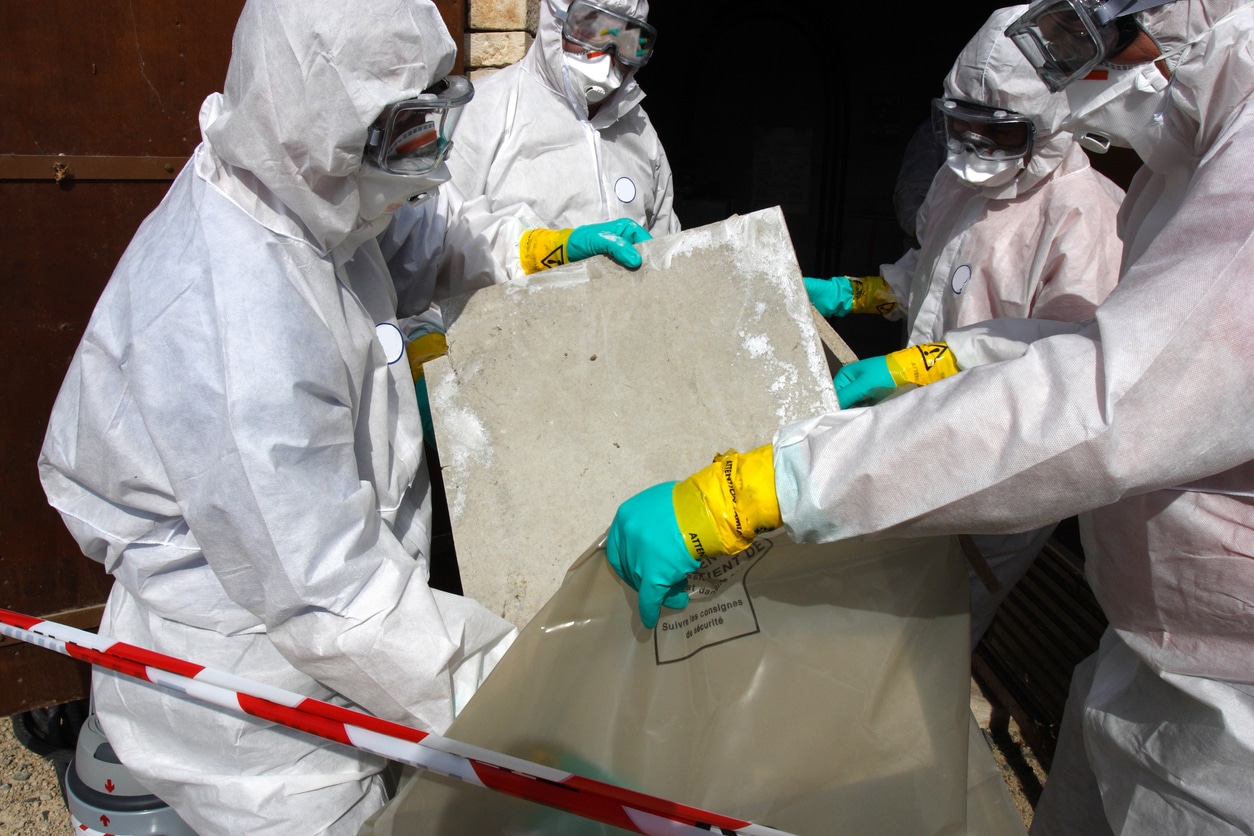Asbestos in Your Home. What to Look for, How to Test.

In the past, we’ve written about various Portland home hazards all homeowners need to be aware of, from underground oil tanks and radon to mold, floods, earthquakes, and landslides. There’s another one to remember when preparing to invest your hard-earned money into a new home or preparing your current home to list it on the market, no matter its age: asbestos!
As real estate agents serving the Portland metro area, we understand the importance of helping clients successfully sell their homes for the highest possible price and providing sellers and buyers with the latest information about potential hazards Portland homes might have.
Most of us think of asbestos as a material used in construction in the distant past, which has been largely eradicated. But the truth is, this naturally occurring mineral with beneficial properties—like being resistant to heat, electricity, and corrosion—could still exist in your home.
Read on to learn about asbestos, where it could lurk in your home—regardless of age- and where the U.S. stands on using it in construction in 2023. But first, let’s look at why asbestos is such a hazard to your family’s health and the laws around its use.
What Is Asbestos?
The name “asbestos” refers to six different naturally occurring minerals. While it may seem surprising that asbestos was used for construction in the past, given its dangerous nature, it is flexible, has a high tensile strength, and is resistant to heat and chemicals. Because asbestos forms fibrous bundles that are long and thin, they can be woven much like fabric, making this an easy product to work with as far as functionality goes.
Asbestos is found in nature, though at much lower levels than one would find in commercially available construction products. In fact, asbestos comes from metamorphic rocks, meaning there are significant deposits of this mineral in the western United States, as well as North and South Carolina.
While asbestos is not used in products made for the general public in the United States, it can still be found in commercial buildings, gaskets, and things like brake shoes and clutches. However, in the past, asbestos was used for a wide range of building materials and home goods, ranging from vinyl flooring and paints to stove insulation, home appliances, and more.
Because asbestos is so flexible and useful as a building material (not considering the personal dangers), it’s important to be extra careful when renovating or purchasing an older home, as any number of materials in that home could contain asbestos. However, even if your home is new, it could still contain asbestos, so be sure to exercise caution when doing repairs or expanding any building, as it is always better to be safe than sorry when it comes to asbestos exposure.
Why Is Asbestos Dangerous?
You may wonder how a type of mineral like asbestos can cause cancer or other serious medical conditions. Because asbestos is made out of long, thin fibers, these fibers can enter the body and get stuck in sensitive tissues, like those in the lungs, abdomen, or throat. Over time, these fibers cause damage to your DNA, which in turn can cause cancer.
Because asbestos was used in so many products, it can be difficult for someone to know if they’ve been exposed to asbestos. Since asbestos can cause cancer over time due to prolonged exposure, someone who has just been exposed to asbestos may not feel any different immediately.
That’s why it’s incredibly important to use caution when working on a home that may contain asbestos, as it can have long-term effects on your health.
How Does Asbestos Enter the Body and What are the Effects of Asbestos?
Asbestos can enter the body through the skin, ingestion, or inhalation, the latter of which is the most prevalent exposure and can lead to serious long-term, even fatal, health conditions like asbestosis, lung cancer, and mesothelioma.
Asbestos can lay dormant for years and be disrupted by standard home maintenance and repairs, remodeling and renovations, or the use of any product, appliance, or equipment containing asbestos. These disruptions can release fibers and particles into the air, making anyone near it vulnerable.
What are the Laws Around Asbestos in the U.S.?
The EPA put a partial ban on asbestos in 1989, which included manufacturing, importing, processing, and distributing certain products containing asbestos. They also banned the sale of any new uses of asbestos as of August 25 of that year.
New restrictions came in April of 2019 to prevent any previously banned asbestos products from returning to the marketplace without the EPA’s evaluation and implementation of restrictions or prohibitions of the substance.
In December 2020, the EPA introduced the Final Risk Evaluation for Asbestos, Part 1: Chrysotile Asbestos, stating the finding of “unreasonable risks to human health for all ongoing uses of chrysotile asbestos.”
After public complaints about the limitations of Part 1 (because it only addresses chrysotile asbestos), in April 2022, the EPA introduced Part 2. This amendment intends to extend to all types of asbestos no longer imported to the U.S. but still present from uses in years past, still posing public health threats. Part 2 prohibits the manufacturing, processing, distribution, and importing of the substance and any other materials or products that contain it. The Risk Evaluation for Asbestos Part 2 will be published before the end of 2024.
Learn more about the EPA’s efforts to protect the public from asbestos exposure.
Push for a Worldwide Ban on Asbestos
In May 2022, Environmental Health Perspectives, a well-respected monthly research journal supported by the National Institute of Environmental Health Sciences, published a report on an asbestos study carried out in Australia that correlated various diseases with asbestos in 70 countries. The hope is that every country will see the risk asbestos poses and create protocols for controlling its use and ultimately banning it.
Despite the World Health Organization‘s (WHO) encouragement to ban asbestos altogether, only 60 countries out of almost 200 worldwide have done so. The U.S. is one of the few developed countries that has not implemented a full-on ban. With asbestos-related diseases on the rise, it is even more imperative to curtail the use of the substance.
Impending Asbestos Ban Fuels Rise in Asbestos Imports
Likely in response to the EPA’s efforts to move toward a ban, stockpiling of asbestos in the U.S. has meant the importation of some 114 metric tons in the first three months of 2022, compared to only 100 metric tons imported in all of 2021, the smallest amount in more than 50 years.
What are the Laws Around Asbestos in Oregon?
The Oregon Department of Environmental Quality (DEQ) website states: “There is no known safe level of exposure to asbestos.” With this in mind, the Environmental Quality Commission implemented increased asbestos program fees as of July 1, 2022. These include but are not limited to increased abatement project notification fees, worker and supervisor certification fees, licensing fees, and training provider accreditation fees.
As of 2018, Oregon adopted asbestos regulations requiring property owners and contractors not just to identify asbestos-containing materials and properly handle them but also to package and dispose of asbestos waste produced from renovation and demolition projects.
Where Could Asbestos Be Hiding in Your Portland Home?
Knowing where to look is the first step in understanding the degree of asbestos exposure you and your family could be subject to so you can take the right steps to remove it or create safeguards. Here are some places to keep in mind.
- Attic and wall insulation can contain vermiculite, a mineral mined in Montana from a site that was contaminated with asbestos. The EPA warns that if you have this material in your insulation, you should assume it has asbestos and take appropriate steps to remedy the problem.
- Hot water and steam pipes coated with any asbestos material, including asbestos blankets and tape
- Oil and coal furnaces and door gaskets insulated with asbestos
- Walls and floors around wood-burning stoves protected with cement sheets, millboard, or asbestos paper
- Vinyl floor tiles and vinyl sheet flooring backing and adhesives
- Shingles for roofing and siding
- Walls and ceilings with textured paint and patching compounds
- Heat-resistant fabrics
See a more extensive list of possible places asbestos might be in your home.
When to Test for Asbestos in Your Portland Home
Simply put, if you plan to renovate your home and you can’t easily identify asbestos-containing material at a glance, hire an accredited inspector to do an asbestos survey of your home. Until you know for sure, treat any questionable materials as if they contain asbestos. A licensed DEQ asbestos abatement contractor can help with an asbestos survey. Following surveys for renovations, property owners may remove the material themselves.
Likewise, for any demolition of a residence built before 2004, homeowners must hire an accredited inspector to carry out an asbestos survey, who will, in turn, produce a survey report. In this case, if friable (crumbling) asbestos is found, it must be removed by a DEQ asbestos abatement contractor before the demolition can occur. A Construction Contractors Board licensed contractor must handle the removal if non-friable asbestos is found.
How to Test Asbestos Found in Your Portland Home
If an accredited asbestos contractor discovers asbestos-containing materials in your home, they can send them to a lab for evaluation. If you locate asbestos when preparing for a remodel, you can take the sample(s) to a lab using the following steps per the DEQ:
- Wet the material with a light water mist before disrupting the area and taking the sample. This reduces the potential release of asbestos fibers into the air.
- Don’t disrupt the material more than necessary: a small (2” x 2”) sample is sufficient.
- Place the sample in a clean, air-tight container. A small jar or zip-lock bag will work. Seal the container tightly to prevent asbestos particles from escaping. Make sure each sample has its own container.
- Clean up any material on the outside of the container or that might have fallen to the floor or other surfaces with a damp paper towel.
- Place a clearly marked label on the container that shows the location and date of the sample taken.
- Send your sample(s) to an accredited asbestos lab for analysis.
Is Your Portland Home Ready for Market?
I’ve seen a lot (licensed since 2003) helping clients get their homes ready to sell in the Portland metro area. I’d be happy to discuss what it will take to make your home list-ready for the market. Call our top 1% seller’s agents today at 503-714-1111, or chat with the bot on our site. Our top 1% buyers agents also know what hazards to help their clients look out for when touring Portland homes. We would be happy to hear about your plans and concerns and help you troubleshoot any potential problems you might encounter.


